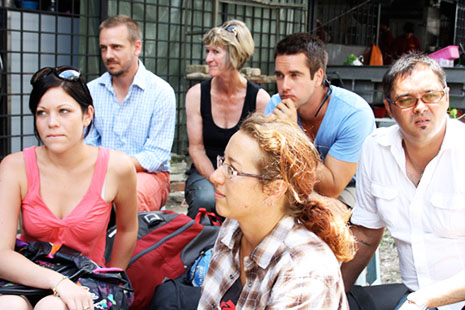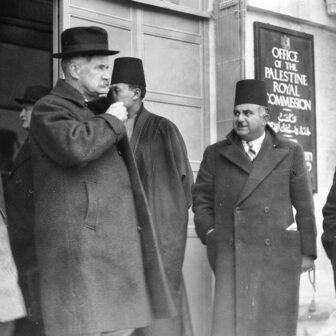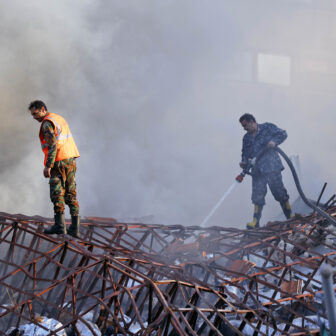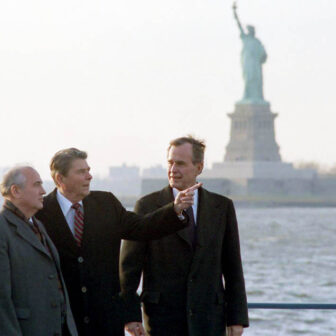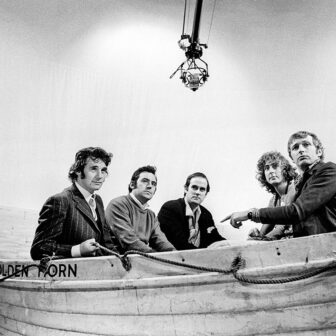In Go Back to Where You Came From, a three-part documentary screened last week on SBS television, six people retrace the steps of refugees who came to Australia as onshore asylum seekers or through Australia’s offshore humanitarian program. Over a five-week period, they travel from Australia via several transit countries to two of the main sources of global refugee movements, Iraq and the Democratic Republic of the Congo.
At the beginning of their journey, the six stay for a week with refugees in Australia: a family from Burundi and the Congo living in Wodonga, and four Iraqi men living in Sydney. Then, in Darwin, they board what appears to be a leaky and entirely unseaworthy boat. Their next stop is Malaysia, where they are hosted by Chin refugees from Burma; later, they accompany Malaysian immigration officials on a raid to flush out illegal immigrants. Three of them travel on to Jordan and from there to Iraq, and the other three journey to the Kakuma refugee camp in Kenya and from there to the Congo. In Jordan and at Kakuma they meet the relatives of the people who had hosted them in Australia.
In SBS’s publicity material for the series, the six participants – three men and three women – are consistently referred to as “ordinary Australians” chosen to represent a cross-section of the Australian community. Five of them embark on the journey with very strong anti–asylum seeker views, and at least three of those five don’t differentiate between asylum seekers and refugees or are antipathetic to refugees as well. Only one of the six, Gleny Rae, a singer and part-time teacher from Newcastle, believes that Australia should welcome refugees and asylum seekers. All six are deeply affected by the five-week journey, and several of them change their views.
The series was aggressively promoted by SBS in the weeks leading up to its first screening, and received a great deal of advance publicity in the media. As SBS’s Anton Enus put it this week, the show produced “nothing short of a phenomenon.” It is the highest-rating program screened by SBS so far this year and triggered an unprecedented response on Twitter and on blogs (including close to 5000 posts, and rising, on the SBS website). During the screening of the first episode, the hashtag #GoBackSBS briefly became Twitter’s number one trending topic worldwide. It is important to keep that in perspective, however; on Thursday, when Go Back to Where You Came From attracted 600,000 viewers in the capital cities, it only came nineteenth on the ratings table. MasterChef Australia, the highest rating show that evening, was watched by two-and-a-half times as many people.
The response to the program was overwhelmingly positive. At least six in every seven comments published on the SBS website praise the show, and these viewers use plenty of hyperbole. Kendall from Melbourne, for example, says: “The most important and topical television program I have ever witnessed.” “The most powerful and brilliant television I have ever seen,” writes Paul from Aldinga Beach. And Tony from Northcote comments: “Thank you SBS!!! I’ll be happy if I never get to watch television again after tonight.”
Many of these viewers liked the show because they found it moving. “Probably the most emotional, thought provoking & moving documentary ever produced on Australian television,” Mark Hearnden from Sydney writes. “This has been the most outstanding, influential, emotional and challenging thing that I have ever seen!” says Sarah from Adelaide. And Kelly from Mulgrave confesses: “I’m in bits here – nothing on tv or any screen has ever moved me as much. It is just so real, so powerful. It’s beautiful watching the changes in these people.”
This brings me to what I consider to be the key issue raised by the series and the public response. In a scene shot in the Kakuma refugee camp in Kenya, Deo Masudi, the brother of the man from Burundi with whom three of the participants had stayed for a week in Wodonga, is talking to those same participants: Raye Colbey, who lives opposite the Inverbrackie detention centre in the Adelaide Hills, Raquel Moore, an unemployed self-confessed “racist” and Pauline Hanson admirer from Western Sydney, and Roderick Schneider, national vice-president of the Young Liberals, from Brisbane.
Deo says, “The big problem of this world is to educate the system to touch heart. If I touch your heart, immediately you are able to understand me. But if I don’t know how to touch your heart – no.” To which Raye Colbey replies, “I highly agree with you. I do think there’s a lot of people out there that do not really see what is happening. They look but they don’t see.”
The hearts of all six participants were touched by their encounters with refugees. In the course of the five weeks, they experienced a rollercoaster of emotions, including fear and anger. Overall, however – as far as I could ascertain on the basis of less than three hours of footage – one emotional response dominated: compassion.
It was their compassion that prompted the six participants to become interested in the issues. Most of them knew very little about asylum seekers and refugees, or about conditions in the countries they hail from or transit through. Their compassion towards the families whose lives they shared briefly in Australia, Malaysia, Jordan and Kenya made it possible for the six participants to look and to see.
Throughout the series, their “guide,” forced migration expert David Corlett, repeatedly refers to the project as a “social experiment.” The experiment demonstrated that the encounter with refugees could turn someone who hated asylum seekers into someone who was able to recognise them as suffering fellow human beings. Raye Colbey, for example, whose response to the Christmas Island boat tragedy of last December had been to say, “It served the bastards right,” wrote an opinion piece sympathetic to refugees that was published in the Age and the Sydney Morning Herald on the day the first episode was broadcast.
The experiment wasn’t without its limitations, though. Not only were the refugees who participated in the series carefully selected, they were also put in the position of hosts: it was the refugees’ ability to extend hospitality to the six Australians, rather than the encounter as such, that produced a transformative effect. In The Response, a forum about the series which was broadcast this week, the six participants were asked to reflect on their experience. Raye Colbey said that the refugees she stayed with were “the most beautiful, beautiful people I think I’ve ever met” and later added what could be read as the main reason for her response: “These people, they open their heart to you… They would give you anything. That’s just the type of people they are.” In other words, for the participants in the social experiment to change and open their hearts, the film-makers needed to find refugees who were prepared to unreservedly welcome a group of privileged Westerners.
The other problem with the experiment is that it cannot be easily extended or even replicated. We – non-refugees – can’t all go to Kakuma and live with a refugee family for a week. We can’t invite ourselves into the houses of refugees resettled in Australia. There are, of course, avenues whereby non-refugees can get to know asylum seekers and refugees. But they tend to be used by people who are already sympathetic to refugees. I am sure there are a million or more Raquels out there – and, as the series amply demonstrates, to change their mind requires an enormous effort. To afford every racist in Australia the opportunity to feel for refugees can’t be the solution.
The producers of the series have emphasised the experimental nature of what was happening on screen. The more interesting experiment, however, took place in front of the screen. The series had a profound impact on those watching it.
GO BACK to Where You Came From is the second Australian TV documentary about asylum seeker issues to move many of its viewers to tears. The first was broadcast ten years ago.
The Four Corners program “The Inside Story” was first screened on 13 August 2001 by the ABC. It was largely about the Villawood detention centre in Sydney and about the persecution that three asylum seekers who’d fled to Australia had faced in Algeria, Iraq and Iran. It became famous, however, for its depiction of Shayan Badraie, a six-year-old Iranian boy who by then had been in Villawood for eleven months and had stopped speaking, eating and drinking. “The Inside Story” used footage of Shayan and his parents filmed three months earlier by Aamer Sultan, an Iraqi detainee who was a trained medical doctor, using a video camera smuggled into the centre.
“The Inside Story” became one of the most talked about current affairs television programs ever shown in Australia. After the broadcast, the program website received over 5000 emails, more than twice the previous record. It had the potential to change the dynamics of the conflict between the supporters and the opponents of Australia’s policy of mandatory detention. This was partly because the latter’s campaign had previously been hamstrung by the invisibility and inaudibility of refugees in detention. “These are voices the Australian public have not heard,” the executive producer of Four Corners wrote in defence of the decision to broadcast Aamer Sultan’s video footage. “Asylum seekers have mostly been faceless, voiceless problems. Seeing them as human beings, perhaps for the first time, led many viewers to respond.” But while viewers may have heard the voices of asylum seekers, they saw only one of them who, importantly, was not able to speak. As the journalist Margot O’Neill wrote in her account of the program, “For the first time, the boat people have a human face; a pale, tormented child’s face.”
“The Inside Story” had an immediate and powerful effect because it allowed viewers to extend their compassion to Shayan and, albeit to a lesser extent, his parents. Because the footage of Shayan and his parents was shot by an amateur under visibly taxing circumstances, viewers’ access to Shayan seemed unmediated.
But what to do about that outpouring of emotion? For the previous two years, the Howard government had been uncompromising in its response to protests in Australia’s detention centres – which included many incidents of self-harm – not least because it wanted to win back voters it had lost to Pauline Hanson’s One Nation party. For a moment, it looked as if the government was on the defensive. Philip Ruddock, the immigration minister, suggested that it was the fault of Shayan’s parents that their child was suffering, but his argument had little impact. The child was pure. He was being hurt. Deliberately. By the government. Our government. Compassion gave way to shame – that is, to an emotion concerned not with the other, but with self.
Whatever emotions were aroused in mid August 2001 among the majority of those who saw “The Inside Story,” the program had largely been forgotten by the end of the month, when the Tampa arrived off Christmas Island with more than 400 asylum seekers on board – people whose faces remained invisible and who could be perceived as a threat. Another two weeks later, the terrorist attacks in the United States prompted Australians to associate asylum seekers, who at the time were predominantly Muslims from Iraq, Iran or Afghanistan, with terrorists. Seemingly having won the debate, the government didn’t, however, so easily forget the lesson of “The Inside Story.” The “children overboard” lies are, in my view, a direct, albeit belated, response to the Four Corners program.
WHAT’S the difference between “The Inside Story” and Go Back to Where You Came From? The SBS series does not, in the first instance, prompt the viewer to extend his compassion towards refugees in Australia, Malaysia, Jordan, Kenya or the Congo. Of course we (non-refugees) can feel for Deo Masudi, the man in the Kakuma camp who calls for our compassion. But that’s largely incidental. The focus of the viewers’ emotions are the six participants. The day after the third episode, Penny from Perth posted the following comment: “I’ve barely slept a wink over the last three nights. I go to bed churning over the sights that have confronted me in SBS’s unbelievably brilliant show.” And what are those sights? The post continues: “I loooove Gleny – go girl for showing such compassion and cultural awareness ie advising Raquel about wearing more clothes, and covering your head in Jordan (that scarf really suits you). I applaud Rae and Raquel on their changes of heart.”
Like many viewers, Jennifer from Bonnet Bay was deeply moved by the show: “I cried throughout the program as my basic instincts as a human being to sympathise and empathise with all involved just overwhelmed me.” But when referring to “all involved,” she seemed to have very particular people in mind: “It is gratifying to see that individuals with such set and negative views can be moved and changed by contact with others whose experiences are just so different and so abjectly harsh by comparison to our own ‘lucky country’ experiences here in Australia.”
In order to understand the impact the series had on its audience we need to take notice of the relationship that developed between the viewers and the six protagonists. The audience empathised with the protagonists, irrespective of their politics. The audience appreciated the significance of the challenge the six participants faced – not because they visited places that aren’t safe but because from very early on it was clear that they would be different people at the end of those five weeks (in fact, make that three nights). One viewer, who said she loved “watching their transformations,” aptly called the six participants “pioneers.” They went where many in the audience hadn’t dared to go – and again, I am not referring to the Congo or Iraq, but to a preparedness to open one’s heart to strangers and to reflect critically on one’s own prejudices.
“The Inside Story” left its audience lost for words. Shayan was so innocent, so pure and, thanks to television, right in their living rooms – yet also so far away. When the program had ended, viewers could only see themselves, and averted their eyes in shame.
The six “ordinary Australians” of Go Back to Where You Came From are by no means beyond reach. They are my next-door neighbour, the mother of my brother’s best mate, the young woman working at the corner shop.
Racist, ignorant and self-centred Raquel – and not any of the refugees featured in the program – ultimately became the star of the show. When some ten thousand viewers tweeted during the first episode, the main subject matter of their messages was Raquel. She was irritating and attracted a great deal of scorn and derision. It was difficult to empathise with her. But it was Raquel, more so than any of the others, who got the audience emotionally involved. The viewers’ emotional investment paid off when Rachel changed during the third episode. “Three cheers for Raquel. Raquel was amazing,” Peter from Geelong wrote after that episode. Jimmy from Sydney commented: “I love Raquel. From pariah to Princess in my eyes.” David from Perth said: “Fantastic & well done Raquel. Watching you mature and develop a lovely smile over three nights spoke heaps.” “You little beauty Raquel! So proud of how far you have come in this journey,” wrote Marianne from Darwin.
It’s worth remembering, however, that the director and his team were able to fashion characters. Condensing five weeks into less than three hours, they selected a small fraction of the footage they had at their disposal. At least one of the participants, ex-soldier Darren Hassan, felt misrepresented. In the show he played the role of the unrepentant tough guy who is incapable of being emotional. His role was as important as that of “pariah to princess” Raquel.
In fact, some of the characters seemed almost scripted. Matt Granfield had a point when he commented after the screening of the first episode: “The token characters were all represented.” References to what wasn’t broadcast, either in the documentary or in last night’s pre-recorded discussion in Sydney – one member of the live audience complained in a post on the SBS website that “all controversial questions” had been edited out – indicate that the show and its overall presentation were very carefully stage-managed.
While “The Inside Story” made viewers feel bad about their country, the SBS program had the opposite effect. “I feel so grateful living in Australia, especially after watching this show,” Chelsea from Newcastle wrote. While the Four Corners program had prompted viewers to identify with their government (and consequently feel ashamed), Go Back to Where You Came From encouraged viewers to barrack for the six participants as if they had been chosen to represent their country in a contest. “Thank god for SBS this is the most amazing series I have EVER seen on TV so proud to see all of the changes with these average Aussies,” Clinton from Melbourne wrote.
If the emotions triggered by Go Back to Where You Came From are foremostly about the six Australians, how useful is such a program in changing the hearts and minds of those whose votes can be bought with cheap slogans such as the Coalition’s “stop the boats”?
I think that in this respect the format of the SBS series actually worked. Compassion as a motivator for action that benefits those who suffer is overrated. Compassion is entirely dependent on a judgement made by the non-sufferer, and it is for the deserving. Imagine if Bahati Masudi, the host of Raquel, Raye and Roderick in Wodonga, had been pompous, aloof or critical of Australia. Imagine if he had ordered his wife around, screamed at his children, and lectured the three Australians. In that case, viewers wouldn’t have cared much about whether or not he will be reunited with his brother.
Compassion that relies on televised images alone is particularly fickle. Viewers are too cynical to believe every sob story they see on the small screen. And even if they are moved, their emotions tend to be fleeting. But the SBS series allowed viewers to rely on others when extending their compassion. They only had access to the footage broadcast on television, but they knew that the six Australians were there, and if they could show compassion against all odds (because they didn’t like refugees to start with) then those sentiments could act as a reliable yardstick.
According to commissioning editor Peter Newman and director Ivan O’Mahoney the aim of the series was not to make viewers take sides. They wanted viewers to appreciate the complexity of global refugee movements. To that end, SBS has provided a host of excellent material on its website – including a quiz, fact sheets and an online simulation that allows users to take on the role of a refugee fleeing an Australia that has descended into anarchy. The series itself also contained a lot of contextualising information. Viewers were able to learn a lot about the scope and complexity of the problem.
Again judging from the responses on the SBS website, many viewers were receptive. The emotions aroused by the series and the identification with the six participants were crucial in allowing viewers to hear that message (or, to use Raye Colbey’s words again, to look and to see). The audience learned with and through Raye and Raquel and Adam and Roderick and Gleny and Darren. And just as the six participants learned about the complexity of the refugee situation because they felt for and with their hosts, the compassion elicited by the series made it possible that the information – which wasn’t new and has always been readily available – was taken in.
Compassion is an important catalyst, rather than a useful end point. The compassion extended to the refugees featured in the series also allowed the six participants – and, by extension, their audience – to think of rights in a concrete way. The response to refugees and asylum seekers needs to be informed by our obligations and capacity, and circumscribed by their rights. Compassion, which focuses on a perceived need, does not take into account a sufferer’s right to relief. But the right to seek and enjoy asylum is too abstract a concept to have much appeal. Like most Australians, at least four of the six participants have a strong sense of entitlement. It was perhaps that very sense of entitlement that allowed them to appreciate that refugees have the right to have aspirations similar to those of Australians, and that they have the right to be given an opportunity to realise those aspirations.
I believe the moral philosopher Lawrence Blum had compassion’s role as a catalyst in mind when he wrote: “True compassion must be allied with knowledge and understanding if it is to serve adequately as a guide to action.” The knowledge that’s crucial here is about the contexts in which suffering occurs, and about how the non-sufferer may be implicated in the sufferer’s predicament.
Viewers of the SBS series didn’t refer to the Four Corners program about Shayan Badraie in their online posts. But they frequently compared the SBS program with the Four Corners report about live cattle exports to Indonesia, broadcast on 30 May. The response to that program led to a ban on that trade. It was watched by fewer people than each of the three episodes of the SBS series.
Many viewers demanded that Australia’s political leaders watch Go Back to Where You Came From and then respond in a similar manner, namely abandon the Malaysian solution. The contrast between the response to the Four Corners program last month and the SBS series last week is stark. The SBS series generated hardly any public debate in the conventional sense. Chris Bowen, Scott Morrison, Julia Gillard and Tony Abbott have not responded to the series; in fact, the only politician I could identify who put out a statement was Lee Rhiannon, the newly elected Greens senator for New South Wales. The commentariat (on both sides of the political fence) was also unusually quiet.
That is not to say that the series hasn’t been intensely debated. But it seems that Go Back to Where You Came From is not so much a subject for parliamentary question time as for discussions at the water cooler or the photocopier. The debate rages on blogs and in the Twittersphere rather than on the opinion pages of newspapers. Those responsible for the program intended this to be something that got “ordinary Australians” talking. This intention was emphasised again in the forum broadcast this week. Combative Jenny Brockie could have hosted the usual experts and politicians; instead, kind, avuncular Anton Enus chaired a gathering of the participants’ family and friends.
I think the creators of the program have been right in not trying to use the show to campaign for a change of policy, but instead focusing on the paucity of the debate, which has been partly responsible for a lot of poor policy in the past. In the unlikely event that the government had responded with a policy announcement (as it did after the program on live cattle exports), such an announcement in itself wouldn’t have changed the parameters of the debate. That debate is marked by a profound lack of understanding (owing to a lack of knowledge of the most basic facts) and by the refusal to acknowledge that some problems are so complex that they defy quick-fix solutions.
It is too early to predict the long-term impact of Go Back to Where You Came From. I would like to see evidence for Peter Newman’s claim that “the series has managed to wrestle back this issue away from the political arena and put it in the hands of the people,” and can’t wait to find out whether or not the emotions aroused by the series will lead to a greater understanding of the complexity of the issues involved in Australia’s response to refugees and asylum seekers. •
